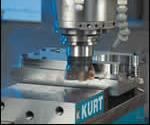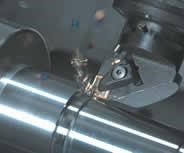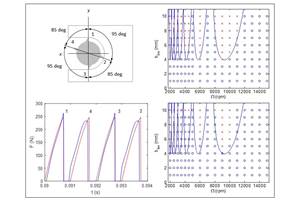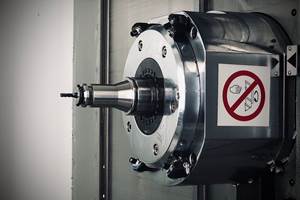Machining Dry Is Worth A Try
Reducing cutting fluid use offers the chance for considerable cost savings. Tool life may even improve.
Share




At a plant we visited recently, the jump in performance that came from removing the cutting fluid took the personnel by surprise. The discovery came by accident. A shortage of cutting fluid forced one shift to machine part of its production quota dry. Necessity being the mother of invention, employees experimented to determine whether they could still produce effectively. What they discovered is that investing in cutting fluids does not necessarily return a dividend.
The economics of using cutting fluids have changed dramatically over the past two decades. In the early ’80s, buying, managing, and disposing of cutting fluids accounted for less than 3 percent of the cost of most machining jobs. Today, fluids—including their management and disposal—account for 16 percent of the cost of the average job. Because cutting tools account for only about 4 percent of the total cost of a machining project, accepting a slightly shorter tool life for the chance to eliminate the cost and headaches of maintaining cutting fluids could be the less expensive choice.
And tool life may not even go down. Because coated carbide, ceramics, cermets, cubic boron nitride (CBN), and polycrystalline diamond (PCD) are all brittle, they are susceptible to the chipping and breaking caused by thermal stresses—especially those found in face-turning and milling operations—that can be aggravated by the introduction of coolant.
In milling, for example, the cutting edges heat and cool as they enter and exit the work. Expansion and contraction from these temperature fluctuations cause fatigue. Eventually a series of thermal cracks resembling a comb will form perpendicular to the edge and cause it to crumble.
Introducing a cutting fluid often makes the situation worse for a simple reason. Most of the cooling effect goes to the parts of the work that are already cooler than the cut. Experts debate whether any cutting fluid at all reaches the cutting zone, the zone between the chip and the part, to control the heat of machining at its source. Fluids tend to cool only the surrounding region—areas that were previously warm—thereby intensifying temperature gradients and increasing thermal stresses.
Tapping, reaming and drilling typically do need the help that a cutting fluid can offer—but not necessarily for cooling. Drilling in particular calls for lubrication at the drill’s tip and flushing to eject chips from the hole. Without fluids, chips can bind in the hole, and average roughness of the machined surface can be twice as high as what is possible with a wet operation. Lubricating the point of contact between the drill’s margin and the hole’s wall can also reduce the torque required from the machine.
Some Materials Like To Stay Dry
In addition to cost and tool life, another factor affecting the choice of dry machining is the workpiece. Sometimes, a cutting fluid can stain the part or contaminate it. Consider a medical implant, such as a ball joint for a hip. Fluids are undesirable where there is the fear of contamination.
The workpiece’s suitability for a dry process also depends on the material. A cutting fluid can be superfluous for cutting most alloys of cast iron, and carbon and alloyed steel, for example. These materials are relatively easy to machine and conduct heat well, allowing the chips to carry away most of the heat generated. The exception is low-carbon steel, which becomes more adhesive as the carbon content falls. These alloys might need a fluid as a lubricant to prevent welding.
Cutting fluids normally are not necessary when machining most aluminum alloys because of the relatively low cutting temperatures. In situations where welding of chips does occur with these materials, highly positive rake angles and sharp edges that shear the material usually solve the problem. However, high pressure coolant may be helpful when cutting aluminum alloys at high speeds where a simple air blast is not enough to help break and evacuate chips.
Machining stainless steels dry is a little more difficult. Heat can cause problems in these materials. It can over-temper martensitic alloys, for example. In many austentic alloys, heat also does not flow well from the cutting zone into the chips because thermal conductivity tends to be low. Overheating at the cutting edge therefore can shorten tool life by an unacceptable amount. Another reason that cutting fluids are usually necessary for cutting stainless steel is that many alloys are gummy, meaning they have a propensity to cause build-up along the cutting edge leading to a poor surface finish.
For a number of materials, dry machining is seldom an option. High-temperature alloys make up an entire class of materials in need of cutting fluids. Cutting in nickel- and chromium-based alloys in particular produces extremely high temperatures that require a cutting fluid to dissipate the heat. The lubricity of a fluid also keeps heat generation to a minimum.
Cutting fluids are mandatory for cutting titanium. Although researchers are studying ways to cut titanium dry, the properties of this material pose significant obstacles for doing so. It is gummy, has low thermal conductivity, and (in the case of some alloys) has a low flash point. Consequently, the chips do not carry the heat away, and the workpiece can get hot enough to ignite and burn. (Magnesium burns easily, too, though it chips readily.) Cutting fluids prevent the problem by lubricating the edge, flushing the chips away and cooling the workpiece. To ensure that the cutting fluid performs these functions well, titanium alloys prefer cutting fluids delivered at high pressure, usually in the range of 4,000 to 7,000 psi.
On occasion, powdered metals also need a cutting fluid to generate a thin coating of oil as a rust inhibitor.
Tools Must Control Heat
While some shops have learned the value of dry machining by accident, many others have failed to see the benefits even when they have purposefully attempted it. The reason is that success at dry machining requires more than just eliminating coolant—it requires a methodical approach to controlling heat in the overall process.
The most important way that the tool affects heat transfer is by creating good chips. Chips can carry away 85 percent of the heat generated from the cutting action and allow only 5 percent to enter the workpiece while 10 percent flows into the tool and elsewhere. Modern chip grooves pressed into the surface of tools are a great help in breaking chips into manageable shapes and sizes. Because the chips are hotter and therefore more ductile than their counterparts in wet machining, they are more difficult to break and more likely to produce dangerous chip tangles resulting in poor surface finishes. Using a chip groove designed to shear stringy materials will help to solve this problem. Although such edges tend to have more positive rakes, they are not as fragile and susceptible to breakage as they would be in wet applications. The high cutting temperatures inherent in dry machining usually soften the carbide slightly, which increases its toughness, reducing the likelihood of chipping and improving the reliability and longevity of the tool.
For the same reason, switching to a slightly harder tool upon going dry rarely reduces tool life or degrades the consistency of the cut. In fact, the opposite is true. The harder substrate ensures that the edge retains its integrity at high cutting temperatures, yet the slight softening prevents it from being too brittle. Consequently, users can specify a harder grade of carbide to resist both the deformation and cratering (chemical dissolution of the tool edge) that would otherwise shorten tool life unacceptably in dry applications.
Because the tools designed for dry machining can be sharper and tend to be freer cutting than their counterparts for wet machining, they actually generate less friction and help to control heat. Studies in drilling have shown that reducing the edge hone to create a sharper drill can reduce the cutting temperature by 40 percent. Not only do sharp edges keep the temperature low, but they also reduce runout and improve surface finish.
Another way to assist chip breakage and evacuation from the cut is to replace a liquid cutting fluid with a gaseous one, shop air being the most common. Although it is not efficient at cooling, a blast of shop air is sometimes enough to blow chips from the cut to prevent them from being re-cut and from transferring unwanted heat into the work and machine. When lubrication is necessary, users can apply a high-efficiency lubricant as a mist that is consumed in the cutting process. The most effective method is a relatively new technique sometimes referred to as minimum quantity lubrication (MQL), which injects minute amounts of coolant through the tool.
Coatings Insulate The Tool
Tool coatings also play an important role in guarding the cutting edge during dry machining. Some of the most effective cutting tool inserts for dry machining combine a specially engineered coating system with a cobalt-enriched zone substrate offering a hard interior and a tough surface. An exceptionally thick, 20-micron multi-layer coating is produced using a combination of conventional and medium-temperature chemical vapor deposition processes. The first titanium carbonitride layer produces the necessary adhesion to the substrate as well as edge toughness. Next, a layer of fine-grained aluminum oxide provides the effective thermal barrier needed for dry machining and high cutting speeds. A second sandwich layer of abrasion-resistant titanium carbonitride helps control flank and crater wear, while the top layer of titanium nitride provides built-up edge resistance and makes it easier to determine the wear on the insert.
Lubricious coatings reduce heat generation by decreasing friction. Coatings such as molybdenum disulfide and tungsten carbide-carbon have low coefficients of friction and can lubricate the cutting action. Unfortunately, these coatings are soft and have relatively poor tool life. To compensate for this limitation, these coatings are often used with hard underlayers, such as titanium carbide, titanium aluminum nitride, aluminum oxide or some combination.
Find The Best Cutting Parameters
Getting good results in dry machining requires more than specifying the correct cutting tools. It’s also important to run them at optimum spindle speeds, feed rates and depths of cut. If changing the groove does not control the chips adequately, for example, try adjusting the feed rate next. Increasing the feed rate usually offers the best results, but in rare instances, a decrease in feed rate can be beneficial.
Using the appropriate cutting parameters can also help to keep heat generation to a minimum. The most obvious way that higher speeds and feeds can do this is to reduce the chip load while getting through the material faster. Spending less time in the cut reduces the time available for generating heat and for letting it soak into the workpiece.
But sometimes lowering the spindle speed by about 15 percent is the best course of action for reducing cutting temperatures. To prevent productivity from suffering, users can increase the feed rate by a comparable amount. Be sure to consult the machine’s torque chart to ensure that the lower speeds and higher feeds do not increase the torque requirements and bog the spindle down. If the torque requirements exceed the capacity of the spindle, choose a tool with a smaller diameter. If the higher feed rate hurts surface finish, then increase the nose radius of the tool to compensate.
In milling, depth of cut also influences cutting temperature because it affects both pressure and the cooling time. Cutting inserts of fully engaged tools spend half their time heating in the cut and the other half cooling in the air. When the step-over is 50 percent, however, they spend only a quarter of a rotation in the cut and three-quarters of the rotation in the air. In other words, an insert spends half as much time getting hot and much more time cooling. Most tool manufacturers determine the depths of cut for optimal cutting temperatures for various hardness ratings, so follow their recommendations.
Machines Play A Role, Too
As the tool ejects the chips from the cutting zone, the machine must do its part to carry the chips away quickly. If the chips accumulate in the bed of the machine or elsewhere for even relatively short periods, then the heat inside the chips also will be able to flow into body of the machine, causing growth and minute distortions that can affect the accuracy of precision work.
Without cutting fluid to flush the chips and to absorb heat, the machine must rely on its design to remove the chips efficiently. For dry milling, horizontal-spindle machines tend to be best because they allow the chips to fall directly onto a chip conveyor under the machine. In fact, some builders have designed their latest HMCs to be open in the center to eliminate horizontal surfaces that can collect chips in the work envelope.
For turning, the preferred spindle orientation is just the opposite. Vertical chuckers are totally enclosed so inertia throws the chips against the walls as the part spins. The chips can then fall to a chip conveyor below. Many builders have designed their latest vertical lathes with inverted spindles, which exploit gravity further.
Although chip conveyors are not standard features on all machines today, they are mandatory for dry machining. A vacuum filter also can remove dust in enclosed machines cutting cast iron and graphite.
No matter how efficient the machine is at removing the chips, it and the workpiece are more sensitive to temperature variations when there is no cutting fluid present to add thermal stability. Consequently, applications involving tight tolerances might need a machine with a symmetrical design and a thermal compensation package to adjust offsets on the fly. Users also might consider measuring critical dimensions on the workpiece periodically with an online probe or at an off-line measurement station to monitor thermal drifting and to take corrective action as necessary.
Another method for controlling thermal fluctuations is to plan the process to keep these fluctuations to a minimum. For example, the operator might have to give the machine time to reach a steady state after starting it in the morning and use automation to keep the machine running during breaks. For applications that perform several operations in one clamping, plan the order of operations to perform the dry machining operations first and the drilling, tapping, and other wet operations last. Taking this precaution keeps usage of cutting fluids to a minimum and prevents them from interfering with the operations that are run dry.
About the authors: Don Graham, Dave Huddle and Dennis McNamara work for cutting tool supplier Seco-Carboloy in Warren, Michigan. They are the product managers for (respectively) turning, advanced materials and milling.
Related Content
The Impact of Cutting Teeth Spacing on Machining Stability
Many cutter designs are available, and variable teeth spacing (or variable pitch) cutters can be used to influence milling stability. Let’s discuss why teeth spacing affects stability.
Read MoreHow to Troubleshoot Issues With Tool Life
Diagnosing when a tool is failing is important because it sets an expectation and a benchmark for improvements. Finding out why gives us a clue for how to fix it.
Read MoreOrthopedic Event Discusses Manufacturing Strategies
At the seminar, representatives from multiple companies discussed strategies for making orthopedic devices accurately and efficiently.
Read MoreQuick-Change Tool Heads Reduce Setup on Swiss-Type Turning Centers
This new quick-change tooling system enables shops to get more production from their Swiss turning centers through reduced tool setup time and matches the performance of a solid tool.
Read MoreRead Next
Building Out a Foundation for Student Machinists
Autodesk and Haas have teamed up to produce an introductory course for students that covers the basics of CAD, CAM and CNC while providing them with a portfolio part.
Read More5 Rules of Thumb for Buying CNC Machine Tools
Use these tips to carefully plan your machine tool purchases and to avoid regretting your decision later.
Read MoreSetting Up the Building Blocks for a Digital Factory
Woodward Inc. spent over a year developing an API to connect machines to its digital factory. Caron Engineering’s MiConnect has cut most of this process while also granting the shop greater access to machine information.
Read More
























.png;maxWidth=300;quality=90)







